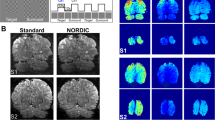Summary.
Transcranial magnetic stimulation (TMS) is a noninvasive method for local stimulation of cerebral cortex using a small coil's pulsed magnetic field. TMS response maps consist of measured responses to stimulations at points on a scalp-referenced grid and are used to study the topography of the brain's inhibitory and excitatory response. Because the magnetic field distributions of stimulation coils are 1–2 centimeters wide and 2–3 centimeters long, and the induced electric fields are even broader, the resolution of TMS maps is limited and the actual region of cortical stimulation is poorly defined. To better characterize the activation pattern, a practical mathematical procedure was developed for deconvolving a spherical model approximation of the coil's induced electric field distribution (here measured in a phantom) from the TMS response maps. This procedure offers an integrated, internally consistent method for processing TMS response maps to estimate the spatial distribution of motor cortex activations and inhibitions.
Similar content being viewed by others
Author information
Authors and Affiliations
Additional information
Received February 7, 2000; accepted July 3, 2000
Rights and permissions
About this article
Cite this article
Bohning, D., He, L., George, M. et al. Deconvolution of transcranial magnetic stimulation (TMS) maps. J Neural Transm 108, 35–52 (2001). https://doi.org/10.1007/s007020170095
Issue Date:
DOI: https://doi.org/10.1007/s007020170095




